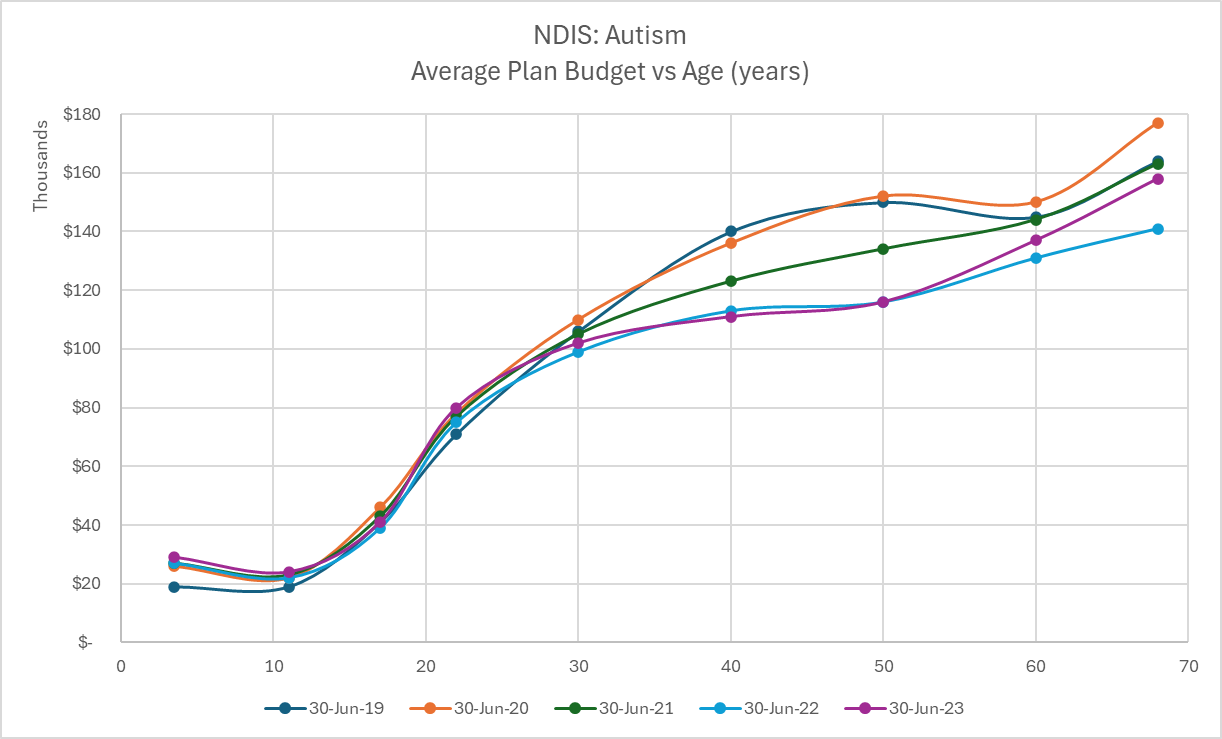The NDIS publishes quarterly data about NDIS participant plans. A4 used these data for the analyses of NDIS costs below.
Following are annual average budget costs for autism in the NDIS from 2019 to 2023 broken down by age.

|
Age years |
0 to 6 |
7 to 14 |
15 to 18 |
19 to 24 |
25 to 34 |
35 to 44 |
45 to 54 |
55 to 64 |
65+ |
|
mid-age |
3.5 |
11 |
17 |
22 |
30 |
40 |
50 |
60 |
68 |
|
30-Jun-19 |
$19,000 |
$19,000 |
$41,000 |
$71,000 |
$106,000 |
$140,000 |
$150,000 |
$145,000 |
$164,000 |
|
30-Jun-20 |
$26,000 |
$22,000 |
$46,000 |
$78,000 |
$110,000 |
$136,000 |
$152,000 |
$150,000 |
$177,000 |
|
30-Jun-21 |
$27,000 |
$23,000 |
$43,000 |
$77,000 |
$105,000 |
$123,000 |
$134,000 |
$144,000 |
$163,000 |
|
30-Jun-22 |
$27,000 |
$22,000 |
$39,000 |
$75,000 |
$99,000 |
$113,000 |
$116,000 |
$131,000 |
$141,000 |
|
30-Jun-23 |
$29,000 |
$24,000 |
$41,000 |
$80,000 |
$102,000 |
$111,000 |
$116,000 |
$137,000 |
$158,000 |
Summing these budgeted amounts across the full age range gives the life-long cost of NDIS support in $AU at the dollar value of each year (these figures will vary a bit if CPI is taken into account).
|
Age |
0 to 70 |
19 to 70 |
|
30-Jun-19 |
$7,269,000 |
$6,820,000 |
|
30-Jun-20 |
$7,552,000 |
$7,010,000 |
|
30-Jun-21 |
$7,045,000 |
$6,500,000 |
|
30-Jun-22 |
$6,407,000 |
$5,886,000 |
|
30-Jun-23 |
$6,647,000 |
$6,088,000 |
At this stage, the NDIS has not provided data showing how much benefit early intervention achieves for children with a disability.
An very conservative estimate would be that early intervention decreases lifetime cost by at least 10% for autistic children. At that conservation estimate of benefit, the breakeven point for the cost of early intervention exceeds $600,000. The data suggests that the NDIS funds very few autistic children at that level. Even autistic children whose supports are decided by the AAT rarely get this level of funding … and those who do usually need substantial support as well as early intervention.
If early intervention is even more effective (resulting in greater reduction in support needs), then the break even point is even higher.
The NDIA’s favourite research involving early intervention for “toddlers with autism spectrum disorder (DSM-5)”, Rogers et. al (2020, the NDIA relies heavily on A/Prof Sandbank’s interpretation of this research in AAT cases about early intervention for autistic children), describes average increased Mullen composite DQ outcomes of 13.5 DQ points (Table 2 - average DQs changed from 64.35 to 77.88). Such an increase in DQ takes many children out of the Intellectual Disability range … that alone suggests substantially greater than average 10% support/cost reduction over the lifetime for toddlers who get evidence-based early intervention for their ASD (DSM-5).
Further discussion of the subject and references to other studies about cost and benefit of evidence-based early intervention for autistic children can be found at https://a4.org.au/node/1554.
In most cases, the NDIA’s cruel policy of sending autistic children who need the most support, who were advised by their clinicians that they need early intensive behavioural intervention (EIBI) for ASD or ESDM/NDBI (both that the NDIA mistakenly calls ABA), to the Administrative Appeals Tribunal (AAT) typically leads to extended delays, typically in excess of 12 months, to access evidence-based (no longer early) intervention for their ASD.
Some research describes outcomes where early intervention for autism or ASD results in little or no ongoing support needs - see Why do some children lose their autism diagnosis? Note that ‘losing their autism diagnosis’ means as functioning neuro-divergent adults they need little or no support … resulting in 100% saving to the NDIS: such outcomes are increasingly likely in our progressively neuro-affirming world that appreciates, or at least accommodates, their difference. If outcomes such as are described in the research literature are achieved in Australia, such individuals impose little/no cost on the NDIS.
It is crucial to appreciate that research reviews advise that:
- there is no one early intervention approach that suits all autistic children, and
- about half the autistic children in Australia are not diagnosed until they are over 8 years old (which the NDIA considers to be too late for early intervention).
Many families do not choose EIBI or NDBI approaches; they regard other approaches as appropriate for their autistic children. Clinicians and reviewers should recognise that parents know their child best and will mostly make good choices about intervention styles for their child if they get all the relevant information (this process was removed when the NDIS shut down the HCWA Autism Advisors).
Results like these are not reported in the NDIS Quarterly reports, in the NDIS Annual Financial Sustainability Review (AFSR) or the NDIS’s “deep dive” on autism data (see A4’s partial commentary on NDIS deep dive into autism data - July 2019).
These cost estimates do not take into account some of the other economic impacts, such as secondary costs to families and the economy, see for example WA study finds Autism sets back families $35,000 per year
The fundamental question is whether the NDIS even is an insurance scheme, and in particular whether it is prepared to risk funding intensive early intervention for autistic children to achieve long-term benefits for everyone … and improve the sustainability of the Scheme.
Bob Buckley
30/1/2024